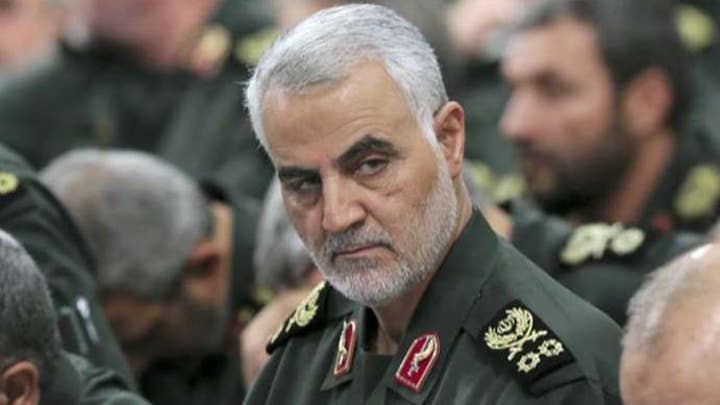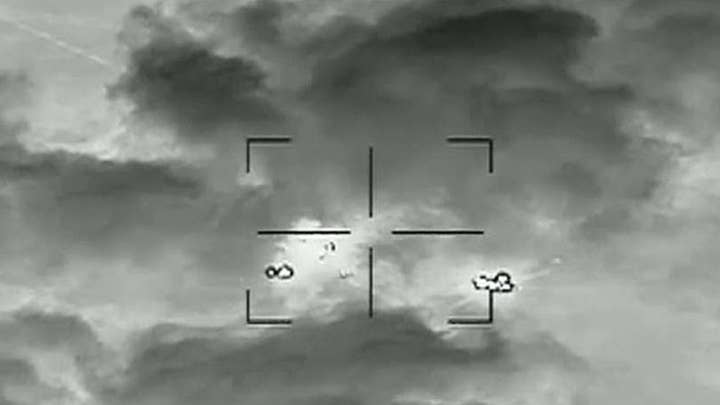US drone strike kills Iranian General Qassem Soleimani
WhiteFox Defense Strategic Advisor and drone expert Brett Velicovich discusses the operation and mission of the airstrike that hit General Qassem Soleimani.
You only get "one shot" while taking down a target like Iranian General Qassem Soleimani, drone expert Brett Velicovich said Saturday.
Appearing on "America's News HQ: Weekend" with host Ed Henry, Velicovich -- who once tracked Soleimani's movements -- said that the drone strike on Soleimani was a " forceful reminder that the Iranians can no longer attack Americans with impunity, [as well as] that the U.S. government can retaliate with a wide variety of options that are both devastating actions that are short of war."
"Thanks to President Trump's decisive action, we are able to use one of the tools within the government's arsenal to strike and to strike Soleimani with precision," he added.
SECURITY UPGRADED AT CAPITOL AFTER SOLEIMANI DRONE STRIKE, SOURCES SAY
The MQ-9 Reaper drone was used to strike Soleimani early Friday at the Baghdad International Airport. With a range of 1,150 miles and the ability to fly at altitudes of 50,000 feet, the Reaper weighs almost 5,000 pounds empty.

Aircrews perform a preflight check on an MQ-9 Reaper before it takes of for a mission in Afghanistan Sept. 31. The Reaper is larger and more heavily-armed than the MQ-1 Predator and in addition to its traditional ISR capabilities, is designed to attack time-sensitive targets with persistence and precision, and destroy or disable those targets. (Courtesy of the United States Air Force)
SOLEIMANI SLAYING: US SEIZES OPPORTUNE MOMENT, BUT RAMIFICATIONS MAY BE COSTLY
According to the U.S. Air Force, the drone system is an "armed, multi-mission, medium-altitude, long-endurance" drone that is designed primarily for offensive strikes.
The Reaper, which became operational in 2007, can also conduct surveillance, assist in search and rescue missions, and allow the U.S. to "conduct irregular warfare operations."
"The MQ9 Reaper is [an] advanced version of what's known as the Predator drone which a lot of people know as the drone used to strike Al Qaeda," Velicovich said. "And, basically, it's used by special operations personnel for surveillance to strike and it's a very sought-after drone that's used."
IRANIAN REVOLUTIONARY GUARD COMMANDER THREATENS ATTACKS ON 'VITAL' US DESTROYERS, WARSHIPS
He told Henry that the Reaper has "an incredible payload" with laser-guided and hellfire missiles which are "all designed to give targeters like [himself] the ability to strike with extreme precision."
Velicovich said that, with a target like Soleimani, "he's priority number one. It's all about precision; you only get one shot."
Velicovich also noted that Baghdad was a "great environment" to be able to fly a drone -- comparing commercial air traffic in Baghdad to Los Angeles International Airport (LAX).
"No one's going to know the difference between a drone flying or an airliner," he stated. "The sound from the drone is muffled so they're able to fly that drone very, very, low and that opens up their sight picture. It gives the individuals the ability to see -- more than likely -- exactly where Soleimani was located within that vehicle."
"It's all designed to give commanders...[who] are authorizing the strike more confidence that it is the individual they say it is," he said. "We could have captured Soleimani easily, but this was a deliberate action on the president to say we're going to throw that option off the table."

Protesters hold up posters of Gen. Qassem Soleimani while mourning during a demonstration over the U.S. airstrike in Iraq that killed Iranian Revolutionary Guard Gen. Qassem Soleimani, in Tehran, Iran, Saturday Jan. 4, 2020. Iran has vowed "harsh retaliation" for the U.S. airstrike near Baghdad's airport that killed Tehran's top general and the architect of its interventions across the Middle East, as tensions soared in the wake of the targeted killing. (AP Photo/Ebrahim Noroozi)
Soleimani was wiped out in the early hours of Friday morning at Baghdad International Airport. President Trump, who authorized the strike, on Friday accused Soleimani of planning "imminent and sinister attacks".
"We took action last night to stop a war,” Trump said during brief remarks at his Mar-a-Lago resort in Florida. “We did not take action to start a war.”
Without divulging details about what led to the early morning airstrike that killed Soleimani and nine others, the president said the United States "caught" the general "in the act and terminated him.”
“Soleimani made the death of innocent people his sick passion,” Trump added, saying that "what the U.S. did yesterday should have been done long ago."

Iraqis surround a coffin, draped in an Iranian national flag, during the funeral procession of Iraqi paramilitary chief Abu Mahdi al-Muhandis, Iranian military commander Qasem Soleimani, and eight others, in the capital Baghdad's district of al-Jadriya, near the high-security Green Zone, on January 4, 2020. - Thousands of Iraqis chanting "Death to America" joined the funeral procession for Iranian military commander Qasem Soleimani and Muhandis, both killed in a US air strike. The cortege set off around Kadhimiya, a Shiite pilgrimage district of Baghdad, before heading to the Green Zone government and diplomatic district where a state funeral was to be held attended by top dignitaries. In all, 10 people -- five Iraqis and five Iranians -- were killed in Friday morning's US strike on their motorcade just outside Baghdad airport. (Photo by AHMAD AL-RUBAYE / AFP) (Photo by AHMAD AL-RUBAYE/AFP via Getty Images)
The killing of Soleimani, the head of Iran's elite Quds Force, marks a major escalation in the standoff between Washington and Tehran, which has careened from one crisis to another since Trump withdrew from the 2015 nuclear deal and imposed crippling sanctions.
Senior State Department officials described the killing as a defensive strike supported by solid intelligence and claimed Soleimani was planning imminent attacks against United States interests and personnel in the region.
The officials said the attacks were being planned in Iraq, Syria and Lebanon, and targeted U.S. diplomats, military personnel and facilities that house Americans. They claimed hundreds of Americans could have been killed.

People attend the funeral of Iran's top general Qassem Soleimani and 9 Iranians and Iraqis, in Baghdad, Iraq, Saturday, Jan. 4, 2020. (AP)
Iran, in response, has vowed "harsh retaliation" for the strike, with Gen. Gholamali Abuhamzeh, commander of the Revolutionary Guards in the southern province of Kerman, threatening an attack on some 35 “American targets,” including “destroyers and warships” near the Persian Gulf.
“The Strait of Hormuz is a vital point for the West and a large number of American destroyers and warships cross there,” Abuhamzeh said according to a Reuters report, citing Tasnim news agency.
“Vital American targets in the region have been identified by Iran since long time ago ... some 35 U.S. targets in the region, as well as Tel Aviv, are within our reach."
CLICK HERE FOR THE FOX NEWS APP
Fox News' Alex Pappas and Paulina Dedaj contributed to this report.



